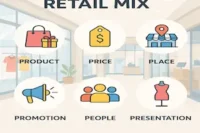General Trade Vs Modern Trade – Key Differences & Their Future
Published: 16 Jun 2025
Trade is the traditional way to earn money. People buy and sell goods to meet their needs and support their families.
But guys, do you know that over time, trade has been completely changed? Today, we see two main types of trade, and they are:
- General trade and
- Modern trade
One is built on personal trust and small stores. The other relies on systems, big brands, and technology. Knowing the difference can help you choose the right path for your business.
Both are important, but they work very differently. General trade is all about small local shops, friendly shopkeepers, and runs on personal trust. While modern trade, on the other hand, includes big supermarkets, clean shelves, barcode systems, and plenty of other things.
So my champs join me today, we will explore everything about general trade vs modern trade. After reading this guide, you will be fully equipped with all of the concepts of modern trade and general trade.
So, are you ready to learn something new today?
What Is General Trade?
General Trade, also known as GT, is the traditional way of selling goods through small, independent stores.
It includes a wide range of shops—from kirana stores to mom-and-pop shops, street vendors, and every outlet that’s run by a small family. These shops are usually found in local neighborhoods, town markets, and village corners.
General Trade stores usually buy products in bulk from wholesalers or distributors and then sell them directly to customers in small quantities.
And guys, do you know one interesting fact about them? Almost 90% of general trade stores do not use advanced digital tools to make their everyday tasks easier or grow their businesses.
Instead of this, they are still relying on:
- Pen and paper to record sales
- Creating strong personal trust instead of using data
- Manual stock checking
- Word-of-mouth credit tracking and
- Daily cash handling with no online systems
That’s said!!
And when it comes to the advantages of general trade for brands,
- They help brand owners reach out to a wide range of consumers who live in traditional neighborhoods or villages. These consumers trust local shops more. They shop close to home and prefer personal service.
- Brands can build strong relationships with shop owners who personally recommend products to buyers.
- Products in general trade stores stay visible for a longer time.
- It’s easier to launch small packs or test new products in these stores.
- General trade also supports cash-based sales, which is still common in many areas.
Issues With General Trade.
While general trade has plenty of benefits for all,
- Consumers
- Brand owners and
- Store owners
But one main fact: nothing is perfect in this world, right? In the same way, general trade also has some challenges, and one of the primary issues is a lack of infrastructure and clout.
Most general trade stores are small in size. They don’t have proper storage, display shelves, or even basic equipment like barcode scanners or billing machines. This makes daily work slow and manual.
Many shopkeepers still use notebooks to record sales. Stock checking is done by memory or guesswork. All of this limits how fast these shops can grow.
Also, general trade stores don’t have the power or influence that big modern retailers have. They can’t bargain for better deals or get special discounts from brands. Their small size and low purchase volumes mean they often pay more per unit compared to large chains.
Another big issue is delayed payments. Many shopkeepers run their stores on a credit system. Customers take items and promise to pay later. This creates cash flow problems and makes it harder for store owners to invest back into the business.
Lastly, because there’s no digital system, it’s tough for brands to track product sales, stock movement, or customer behavior. Without data, it’s hard to plan, improve, or grow.
What Is Modern Trade?
Modern trade, or MT, is the new, organized way of selling goods through large stores, especially using
- Supermarkets
- Hypermarkets, and
- Chain retailers.
These stores are usually part of bigger brands or companies, and they use advanced technology to make shopping easier for customers and business owners alike.
In modern trade, stores are well-organized with clearly marked shelves, barcodes, and a proper billing system. They often sell products in larger quantities and offer a wide variety of goods in one place, such as food, household items, electronics, and more.
Shopping is fast and efficient, and customers can find most things they need in a single visit.
That’s said!!
Key Features of Modern Trade.
Modern trading outlets highly rely on technology. For example
- They use barcode scanners, billing machines, and digital systems to manage sales and stock. Everything is well-organized and easy to track.
- These stores follow a fixed process. Products are arranged neatly on shelves. Prices are clearly marked. Customers can shop comfortably without asking the staff for every item.
- Modern trade stores also offer card payments, loyalty programs, and discounts. Some even allow online orders and home delivery. All these features make shopping faster and more convenient.
- For brands, modern trade gives better visibility. Products are displayed professionally, and promotions can reach more people. Also, the use of data helps brands understand what is selling and what is not, which ultimately helps the brand owners make informed decisions.
Challenges With Modern Trade.
Guys, of course, modern trade has changed the level of scalability for brands, but it still has some downsides.
- It requires a lot of money to open a new store. You will need to buy or rent a handsome amount of space, train your staff well, and buy every digital and physical tool for a better setup and response.
- It also comes with strict rules. Many big stores ask for heavy discounts, long credit periods, and fixed supply terms, which can be hard for small brand owners.
- Small or new brands struggle to get space. Most shelves are already filled with big, known products.
- There’s no personal connection. In modern trade, shoppers pick items by themselves. No one is there to give personal advice or build trust.
- If any system breaks—like billing or stock software—everything stops. The whole process depends on machines.
- Modern trade stores are mostly in big cities. People in small towns and rural areas still don’t have access to them.
So yes, modern trade is fast and organized, but it’s not easy for everyone to join or succeed in it.
Got it! Here’s a simplified two-column table comparing General Trade and Modern Trade, exactly as you requested:
General Trade vs Modern Trade. Quick Difference.
Guys, here I have listed the key differences between modern trade and general trade to help you understand them within minutes.
| General Trade | Modern Trade |
| General Trade includes small, independent shops like kirana stores, mom-and-pop stores, and vendors | While modern trade includes Large stores like supermarkets, hypermarkets, and chain outlets |
| Usually run by individuals or families | Managed by companies or big retail brands |
| Found in local markets, neighborhoods, and rural areas | Mostly located in cities and urban locations |
| Uses pen and paper for billing and records | Uses digital tools, billing systems, and barcodes |
| Basic setup with limited shelf space | Well-organized layout with wide, clean aisles |
| They build a strong personal connection with customers | Less personal, mostly self-service |
| Uses cash and a word-of-mouth credit system | Accepts cash, cards, UPI, and other digital payments |
| Products are displayed in a simple and crowded way | Products are neatly arranged with clear pricing |
| No proper tracking or data | Full sales, stock, and customer data tracking |
| Easier entry for new and small brands | Tough entry for new brands, needs more money and approvals |
| Strong presence in villages and small towns | Strong presence in metro cities and big towns |
How Modern and General Trade Work in the FMCG Sector?
In the FMCG sector, general trade plays a big role in reaching everyday customers. Products like soaps, snacks, toothpaste, and cooking oil are sold through kirana stores, mom-and-pop shops, and small local outlets. These shops build strong relationships with their buyers and know their daily needs. They often sell products in small packs at affordable prices, which is perfect for middle- and low-income families. Distributors or wholesalers supply goods to these stores, and store owners sell them directly to customers. It’s a fast-moving, trust-based system that keeps local areas well-stocked.
On the other hand, modern trade in FMCG is more structured and technology-driven. Big retail chains like supermarkets and hypermarkets stock a wide range of FMCG products all in one place. Items are displayed neatly, and customers can pick what they need without asking anyone. These stores often give discounts, loyalty rewards, and offer digital payment options. For brands, modern trade gives more control over product visibility, promotions, and real-time data tracking. This helps in planning better sales strategies and launching new products more smartly.
Future Trends in Trading Practices
Guys, trading is changing fast, and the future looks exciting! One big trend is digitization. More small shops in general trade are starting to use mobile apps, QR codes, and digital payment systems.
This will help them work faster and smarter. At the same time, modern trade is going more online. Big stores are building apps and offering home delivery to make shopping easier.
Another strong trend is data-driven selling. Brands are using customer data to plan what to sell, where to sell, and when to give offers.
Sustainability is also growing. Many stores now prefer eco-friendly packaging and local products. And guess what? Omnichannel retail is rising too—this means brands will sell both offline and online at the same time. So, whether you’re a small shopkeeper or a big brand, staying updated with these new trends is the key to future growth.
Hey My Champs
So today we’ve deeply understood what’s the difference between general trade and modern trade.
We saw how general trade is all about personal trust, small local shops, and strong connections with everyday customers. And how modern trade brings in big stores, smart systems, and wider reach with the help of technology.
Both have their own pros and cons, but they also serve different needs. Some brands grow faster in general trade, while others shine in modern trade. And many smart brands are using both to grow even faster!
Now it’s your turn—look at your product, your market, and your goals. Then choose the trade style that suits you best.
And always remember: it’s not about big or small—it’s about smart moves and happy customers.
Till next time, keep learning, keep growing!

- Be Respectful
- Stay Relevant
- Stay Positive
- True Feedback
- Encourage Discussion
- Avoid Spamming
- No Fake News
- Don't Copy-Paste
- No Personal Attacks



- Be Respectful
- Stay Relevant
- Stay Positive
- True Feedback
- Encourage Discussion
- Avoid Spamming
- No Fake News
- Don't Copy-Paste
- No Personal Attacks





